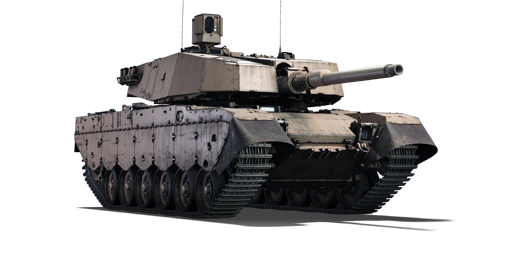

Ground Vehicles
Olifant Mk.2
VI
Rank
AB
9.3
RB
9.3
SB
9.3
Battle rating
Great Britain
Game nation
Medium tank
Main role
220,000

Research
620,000

Purchase

South Africa
Operator country
General information
Survivability and armour
Armour
front / side / back
Hull
76 / 51 / 38 mm
Turret
152 / 89 / 20 mm
Visibility
129 %
Crew
4 persons
Support systems
Mobility
Max speed
Forward
5864 km/h
Backward
2124 km/h
Power-to-weight ratio
17.415.433.126.9 hp/t
Engine power
1,0509292,0031,627 hp
Weight
60.5 t
Optics
Gunner
Commander
Driver
Optics zoom
3.0x–8.0x
2.0x–8.0x
—
Optical device
Armaments
105 mm GT-8 cannon
Ammunition
64 rounds
First-order
13 rounds
Reload
basic crew → aces
8.7 → 6.7 s
Vertical guidance
-10 / 18°
Turret Rotation Speed
basic crew → aces
Horizontal
15.713.429.621.4 → 22.519.142.430.6 °/s
Vertical
75.624.515.7 → 1083522.4 °/s
| Ammunition | Type | Armor penetration (mm) at a distance: | |||||
|---|---|---|---|---|---|---|---|
| 10 m | 100 m | 500 m | 1000 m | 1500 m | 2000 m | ||
| HEATFS | 400 | 400 | 400 | 400 | 400 | 400 | |
| APFSDS | 338 | 336 | 330 | 323 | 315 | 307 | |
| APFSDS | 430 | 428 | 420 | 411 | 401 | 391 | |
7.62 mm Browning MG4 machine gun (coaxial)
Ammunition
6,750 rounds
Belt capacity
250 rounds
Reload
basic crew → aces
10.4 → 8 s
Fire rate
500 shots/min
| Belt | Belt filling | Armor penetration (mm) at a distance: | |||||
|---|---|---|---|---|---|---|---|
| 10 m | 100 m | 500 m | 1000 m | 1500 m | 2000 m | ||
| AP/T | 13 | 12 | 7 | 3 | 2 | 0 | |
Economy
Repair cost
Basic → Reference
AB
3,949 → 6,235 

RB
4,029 → 6,362 

SB
5,149 → 8,130 

Crew training
175,000 

Experts
620,000 

Aces
2,100 

Research Aces
1,010,000 

Reward multiplier
AB / RB / SB
150 / 200 / 240 % 

226 % 

Total cost of modifications
184,100 

305,000 

Talisman cost
2,700 

Research order:
Mobility | |
|---|---|
Protection | |
|---|---|
Firepower | |
|---|---|
Rating by players
You must play more than 3 battles for the last week and more than 10 battles in a vehicle to rate it.
Like:
36
Armor protection:
Not enough ratings
Survivability:
Not enough ratings
Mobility:
Not enough ratings
Armament:
Not enough ratings
Balance:
Not enough ratings
Tips & Tricks
This space is currently empty
Do you know any interesting vehicle features?
Loading...
No articles about this vehicle yet
Become the first author and get rewards!
Write a guide, tell about interesting historical facts, make a tutorial or simply an interesting post.
No more content